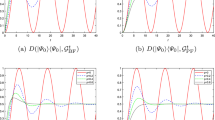Abstract
The problem of generating sequences of uniformly distributed pseudorandom numbers is considered. A simple visual test for estimating the randomness of numbers in a sequence is used. The test shows that the most popular modern random number generators, such as the Mersenne Twister, linear congruential sequence, and others, yield unsatisfactory results. Accordingly, the generation of good generators remains an open problem, and results of computing stochastic processes (molecular dynamics method, etc.) have to be treated with caution.















Similar content being viewed by others
REFERENCES
E. A. Tsvetkov, “Empirical testing of some pseudo-random numbers generators,” Math. Models Comput. Simul. 3 (6), 697–705 (2011).
M. Matsumoto and T. Nishimura, “Mersenne twister: A 623-dimensionally equidistributed uniform pseudorandom number generator,” ACM Trans. Model. Comput. Simul. 8 (1), 3–30 (1998).
M. Matsumoto and M. Saito, “A PRNG specialized in double precision floating point numbers using an affine transition,” Monte Carlo and Quasi-Monte Carlo Methods (2008). https://doi.org/10.1007/978-3-642-04107-5_38
S. K. Park and K. W. Miller, “Random number generators: Good ones are hard to find,” Commun. ACM 31 (10), 1192–1201 (1998).
M. Mascagni and A. Srinivasan, “Parameterizing parallel multiplicative Lagged–Fibonacci generators,” Parallel Comput. 30, 899–916 (2004).
P. L’Ecuyer, “Good parameter sets for combined multiple recursive random number generators,” Oper. Res. 47 (1), 159–164 (1999).
J. K. Salmon, M. A. Moraes, R. O. Dror, and D. E. Shaw, “Parallel random numbers: As easy as 1, 2, 3,” Proceedings of the International Conference for High Performance Computing, Networking, Storage and Analysis (SC11) (ACM, New York, 2011).
G. Marsaglia and W. W. Tsang, “The ziggurat method for generating random variables,” J. Stat. Software 5, 1–7 (2000).
G. Marsaglia and A. Zaman, “A new class of random number generators,” Ann. Appl. Probab. 1 (3), 462–480 (1991).
B. A. Wichmann and I. D. Hill, “An efficient and portable pseudo-random number generator,” Appl. Stat. 31 (2), 188–190 (1982).
RAND Corporation. A million random digits with 100 000 normal deviates (Free Press, 1955).
I. M. Sobol, “Distribution of points in a cube and integration nets,” Usp. Mat. Nauk 21 (5), 271–272 (1966).
I. M. Sobol, Numerical Monte Carlo Methods (Nauka, Moscow, 1973) [in Russian].
ACKNOWLEDGMENTS
We are sincerely grateful to I.M. Sobol, I.A. Kozlitin, and D.D. Sokolov for helpful discussions.
Author information
Authors and Affiliations
Corresponding authors
Additional information
Translated by I. Ruzanova
Rights and permissions
About this article
Cite this article
Belov, A.A., Kalitkin, N.N. & Tintul, M.A. Unreliability of Available Pseudorandom Number Generators. Comput. Math. and Math. Phys. 60, 1747–1753 (2020). https://doi.org/10.1134/S0965542520110044
Received:
Revised:
Accepted:
Published:
Issue Date:
DOI: https://doi.org/10.1134/S0965542520110044




